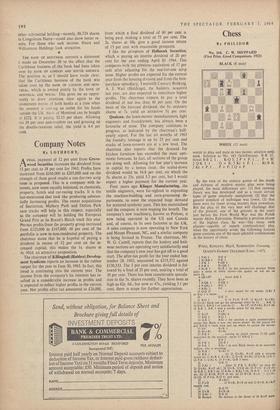Chess
By PHIL1DOR No. 164. C. W. SHEPPARD (First Prize, Good Companions, 1921) BLACK (8 men) WHITE (12 men)
WHITE to play and mate in two moves; solution next week. Solution to No. 163 (Schiffmann): R-B 31, threat B-B 2. 1 . K-Q 5; 2 P X P. 1 . P x B; 2 Q-K 3. 1 . . Q X B; 2 Kt x P. 1 . . . Kt-B 4;
2 Kt x P. I P X P; 2 Q x P.
By the turn of the century games of the depth and richness of modern master play were being played; the main differences are: (I) that opening theory was less developed and as a result certain types of game relatively unexplored; (2) that the general standard of technique was lower; (3) that there were far fewer strong masters than nowadays. But the play of the very best will Challenge that of the present; one of the greatest in the years just before the First World War was the Polish master Akiba Rubinstein. Primarily a position player of the highest class, he was—like many such players—capable of superb combinational play when the opportunity arose; the following famous game contains one of the most splendid combinations in the history of chess.
White, Romawt; Black, RUBINSTEIN: Opening, QUEEN'S GAMBIT DECLINED (LODZ. I 'TO).
I P-Q 4 P-Q 4 2 Kt-KB 3 P-K 3 3 P-K 3 P-QB 4 4 P-B 4 Kt-QB 3
5 Kt-B 3 Kt-B 3. In this symmetrical position White plays a series ot feeble moves—the upshot we will see on move 14.
6 QP xP7better B-Q 3
6 . ._. 13XP
7 P-QR 3 P-QR 3 8 P-QKt 4 B-Q 3 9 B-Kt 2 0-0
10 Q-Q 2? . . a poor square for the queen. Q-Kt 3
i or B-Q 3 s better.
10 . . Q-K 2!
II B-Q 3 ... if H PXP, PxP; 12 KtxP, KtxKt; 13 Qx Kt Black can get the advantage either by 13 . . . B-K 3; 14 Q-Q 2, KR-Q I or even by 13 .. Kt x P; 14 P x Kt, BxP ch; 15 K-K 2. B-K 3 with a terrific attack for the Piece.
11 P x P 12 13 P-QKt 4
13 B-11Q 3 R-Q 1 14 Q-K 2 13-Ki 2 the position Is again symmetrical—
except that Black is now two moves ahead! He hag played 0-0 and KR-Q 1—look back and see where he gained the moves.
15 0-0 Kt-K 4 16 Kt x Kt Bx Kt 17 P-B 4 . . starting an attack (moves 17-19) quite unjustified by the position: better 17 KR-Q 1.
17 . . . .13-B 2
18 P-K 4 QR-B I 19 P-K 5 134(1. 3 ch now Black shows, in no unceriein fashion, who is attacking.
20 K-R 1 Kt-Kt 51 21 B-K 4 . . . (a) 21 QXKt, R x B with a winning
attack (b) 21 Kt-K 4, RxB!; 22 Ox R. Bx Kt; 23.QxB, Q-1( 5; 24 P-R 3, Q-Kt 6; 25 Px Kt, Q-R 5 mate.
21 . . Q-R 5/ 22 P-Kt 3 . . . After 22 P-R 3, RxKt! we have (a) 23 131xKt, RXP chi; 24 QxR, QXQ ch; 25 P x() B x B ch; 26 K-R 2, R-B 7 ch; 27 K-Kt 3, R-Kt 7 ch; 28 K-It . 13.Q I ch etc. (b) 23 BxB, RxP ch etc. (c) 23 BxR, Bx.h. .i4 Q x Kt, QXQ; 25 PxQ, R-Q 61 and wins.
22R x Kt!! 23 P;(6 . . . 23 BXR, BXB ch and 23 BxB, R xKLIP equally lose.
23R-0 711
24 ixit Bx13 ch 25 Q-Kt 2 R-R 6! • 26 Resigns No defence to the threat of 26 RxP mate.






































 Previous page
Previous page